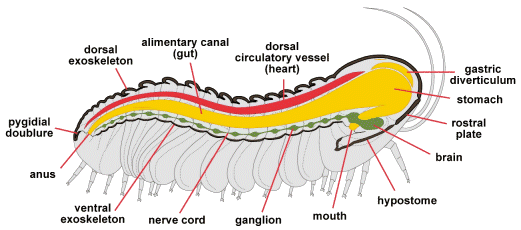|
last revised 28 February 2009 by SMGIII 
.. Trilobite Internal Anatomy This drawing ©2004 by S. M. Gon III In the figure above, a longitudinal sagittal section taken through the midline of the axis of a phacopid trilobite reveals some of the major systems. The thick dorsal exoskeleton (composed of a complex structure of chitin and protein, thickened and hardened by calcite (calcium carbonate [CaCO3]) and much thinner ventral shell (uncalcified), are shown in dark brown. The dorsal circulatory vessel (heart) is shown in red. Modern arthropods have an open circulatory system in which internal organs are bathed in hemolymph (blood) which is circulated through contractions of the dorsal circulatory vessel. The digestive system (yellow) starts at the mouth (adjacent to the hypostome), which feeds forward into a stomach which occupies much of the glabellar space. From the stomach, a long alimentary canal sends food backward to exit at the anus. Accessory digestive organs, sometimes referred to as gastric diverticulae occur both above and to each side of the stomach (see another example below). We presume that trilobites had a ventral nervous system, either a pair of nerve cords connected at segmental ganglia (swellings), or perhaps a single cord with segmented nodes (shown above in dark green). The brain would be an enlarged frontal ganglion receiving sensory input from eyes and antennae, etc. Its precise placement is conjectural, but most modern arthropod brains are anterior to the mouth, with the paired central nerves passing to each side of the esophagus, rejoining at a subesophageal ganglion. In the figure above, the muscular system is not shown (but see below). The reproductive system of trilobites is also very poorly understood. There is some evidence that eggs were brooded at the front of the cephalon (as they are in horseshoe crabs today), but the nature and location of copulatory organs has never been documented. |




